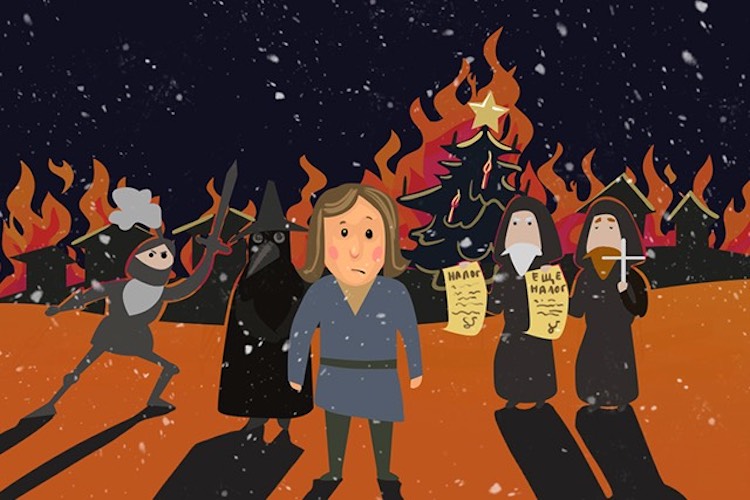Paleogenetics
Biologist Steven Benner on the questions answered by paleogenetics, how laboratory work in the field is conduc...

The European Middle Ages are especially interesting because it’s a culture that was in many ways very different from ours, and yet in many ways, it is also the same. Modern Western culture is descended from Medieval European culture, and so we have inherited a lot of their ideas, but we use them very differently.
So it makes for very interesting and different comparisons. If you compare, say, modern America with Ancient China, then any influence that there is has been very indirect, if at all. Whereas influence from Medieval Europe is very direct and we see ideas still being turned around.
There are a lot of different sources on sex in the Middle Ages. One of the most interesting types of sources is the records of church courts. In Western Europe, the Church was responsible for any laws affecting personal morality. Those cases would end up in the church courts rather than secular courts, and in many jurisdictions, in the Later Middle Ages, we have records from the church courts.
The court records from late medieval Paris was really surprising as they revealed how much sex seemed to be going on in the stables. Why were so many people having sex in the stables? It took me a while to realize that was where the male servants slept. So, if they are taking a woman to their bedroom, they are taking her to the stables.
So, court records are important because they give such a vivid idea about people’s lives and their own testimony. On the other hand, that doesn’t mean that the testimony is always accurate. People often go to court and try to give the best impression of themselves.
There are lots and lots of other kinds of sources. There is literature that talks about sex, poetry, and prose, especially poetry. There are lots of texts written by churchmen about what people ought to be doing: we have sermons, we have treatises, we have didactic works written for laypeople to read, to explain religion to them. It talks about what they should and shouldn’t be doing. We have handbooks for priests and guides to writing sermons, with collections of little stories to include. Some of them are alphabetized, so in case you want to say something in your sermon about, say, women, you look up «women», and it gives a choice of stories. A disproportionate amount of them is about women’s sexual lust. We have writings from only very few individuals about their own activity. We have, for example, the so-called autobiography of Peter Abelard, and then we have an exchange of letters between him and Heloise, where they talk about their illicit relationship and their marriage and subsequent turn to religion. But that’s very rare to have a such personal testimony. However, there’s a very wide range then of kinds of sources, and it’s like a puzzle putting them all together.
There are not many material sources, though. We have things like manuscript illuminations that indicate, for example, couples in bed together. It’s interesting when you see couples in bed naked but wearing headgear. That’s not a reflection, most likely, of how people actually went to bed; actually, the headgear is there to indicate status. That’s an example of how you can’t take an illustration and just say: «Oh, this is what people really looked like».
There are depictions of sexual themes in capitals in churches. The capital is the part that sits on top of the column connecting it to the arch that it’s holding up. Capitals are very often decorated. In some places, particularly in France in the central Middle Ages, we have a lot of capitals that in some way can tell a story. You get classical themes, like the Rape of Ganymede, and you get the stories of adulterous women being tortured in hell by having snakes and frogs sucking on their breasts. We know what the story is because we can connect it with written text, but it’s depicted very graphically in some of these capitals.
As far as the material culture of everyday life goes, it’s very difficult to connect particular things with the history of sexuality. To survive

things had to be made out of a durable material like metal. A lot of the things that would have had to do with sexual activity were not so durable. For example, when we read about medieval women using dildos, they are made out of leather. That’s not going to survive, or if it does, it’s going to be a scrap of leather, and we don’t have any way of knowing that that was its particular use. One of the metal things that survive is the tin badges that people wore on their clothing. If you went on a pilgrimage to a particular spot, you were given a badge as a sign that you’ve been there, or you could buy it as a souvenir. There are a lot of similar tin badges, which may or may not have been given on pilgrimages, that have things like flying phalluses. They clearly have something to do with the history of sexuality, although it’s not clear exactly what those things meant. It might have been the equivalent of people today wearing a t-shirt with a slogan that’s a little bit off-color and intended to shock people and be humorous.
There was a lot of teaching and a lot of preaching about how dangerous lust was and that people, especially women, were very likely to fall into temptation. Now, the clergy themselves, in Western Europe and particularly after the 11th century, were unmarried and were supposed to be chaste. We get all this literature written by men who were not married and who were supposed to be avoiding women, so of course, they are going to write about how women pose a temptation. When people go through life unable to have sex – even if it is by choice, they may still feel frustrated or tempted; if it’s not by choice all the more they are going to feel frustrated or tempted – they are going to write about their temptations and work it out in the literature. That’s a very pop-Freudian sort of explanation, but this is a big part of what’s going on because people are concerned with what creates personal worries for them. And some of the texts that we see are a reflection of their concerns.
Of course, with the peasantry, which was 90 percent of the population, it’s very hard to know anything. We can know about sex from the guides for preachers, for example. We know what was preached to them, but that doesn’t mean we know how they understood it. Judith Bennett has done some interesting work on English peasants and on leyrwite which is a fine levied not by the Church but by manorial lords on peasant women who had sex without being married. It was sort of a method of social control but also as a way of tracing the numbers of single women and their activity. But overall, it’s really hard to know how people interpreted the messages of the Church.
Now, once we get to a later period, there are baptismal records. In England, for example, after the Reformation, churches started keeping records of marriages and baptisms in each parish. Scholars had connected them to determine when, in relation to marriage, the first child was born and, depending on where in England you are in the 16th century, between 10 and 30 percent of women were likely pregnant at the time of their marriage. Many more must have had sex before marriage and not gotten pregnant. It may be that it was fairly common for people to have sex before marriage, and they got married when the woman got pregnant. In church court records, we can often find stories about women who were pregnant and claimed that the man had married them or had promised to marry them, and they asked for that promise to be enforced. So, the common people are not sticking strictly to the «no sex until marriage» rule. There has hardly been an era when they did. But it’s very hard to hear the voice of your average person, except sometimes in the church court records.
The Church taught that the purpose of sex is reproduction, although they didn’t forbid, for example, married couples from having sex after menopause. Reproduction is not the only thing that made sex permissible, but it was a big thing. I would argue that the close connection between sex and reproduction really is not broken until the availability of effective contraception, which means we are talking about the second half of the 20th century. Although there were some forms of contraception earlier, there was not much effective contraception in the Middle Ages.

Sometimes it is argued, on the basis of the demography, that medieval families were actually relatively small– not small compared to modern families, but small compared to what you’d expect. People have this image of every family having 8 to 12 children, but that wasn’t the case. However, some scholars argue that to keep their families’ sizes where they were, people must have been practicing contraception. That’s not necessarily true because, first of all, we don’t know how many people grew to adulthood, and we don’t know how many children died in infancy. We get a family size from things like tax records, which only sometimes give numbers of household members. And they don’t tell you how many died in infancy or how many miscarriages there were. In a relatively malnourished population, that number is going to be higher. It’s also the case that people breastfed their children: richer people sent them to the wet nurse, and poor people breastfed themselves. And in a relatively undernourished population, you are less likely to get pregnant when you are breastfeeding. That doesn’t mean you never get pregnant when you’re breastfeeding – people should not rely on this as a method of contraception – but it inhibits ovulation, so it is likely to lead to fewer births. So, there are a lot of other things besides contraception that might have kept the population rate down.
The other thing that scholars argue about in relation to contraception are warnings about how women should beware of doing something because it will cause miscarriage. Some scholars have argued that that’s a form of a recipe for contraception: saying that women should not do this because it might cause miscarriage is a way of saying women should try this if they want to abort a fetus. However, Monica Green, who is the leading scholar on women’s medicine in the Middle Ages, has argued convincingly that most people really did want children and that the things you shouldn’t do to avoid miscarriage were not intended to tell people how to cause abortion. There are some medical texts that do implicitly suggest ways of avoiding conception, and it’s very difficult to know how widely these were practiced.
In Christian society, the Church forbade official contraception. In Jewish society, they didn’t forbid it. They allow, for example, the use of a sponge under specific circumstances, such as a pregnant or nursing woman. It’s noteworthy that Jewish culture allowed marital intercourse under these circumstances rather than just prohibiting it. In the Muslim world, the later evidence suggests that contraception is permitted. Having large families may have been considered a good thing, as that way someone finds favor in God’s eyes, but contraception wasn’t considered sinful. It’s not like avoiding God’s plan like it was in Christianity.
The Jews, like the Christians, were quick to blame women for temptation, though Jewish cultures were not really separate from the majority cultures in which they lived. So, you will see big differences between Jews in the area called Ashkenaz, which is mainly France and Germany, and Sepharad, which is Iberia. For example, plural marriages were forbidden in Ashkenaz after the 11th century, but not for Jews in Spain, who lived in a Muslim culture that permitted plural marriage.
In the 21st century we – it’s always difficult to say «we» because who are «we»? But let’s say educated people in the West – tend to separate sex from gender. You can be interested in having sex with women, and it doesn’t make you a man. You can be a woman who has sex with women; you can be a man who has sex with men. And that’s separable from your gender. You can be a very feminine woman or a very masculine woman and still want to have sex with men.
In the Middle Ages, they tied sex very much to gender. Sex was all about the role. If you were the active partner, you were playing the masculine role; if you were the passive partner, you were playing the feminine role. They envisioned sex very much as something one person does to another, that a man does to a woman. If two men are having sex, one of them has to be acting as a woman; if two women are having sex, one of them has to be acting as a man. So they mapped sex onto gender where we can dissociate it. This, to me, is one of the most interesting comparisons, the way they understood sexual object choice differently.
Medieval people also didn’t project object choice identity the way we do. People identify as gay, lesbian, bisexual, and so on today. Medieval people didn’t name these categories; although they used the word «sodomite», which had a lot to do with actions and not just with preferences. They didn’t have a completely clear and distinctive vocabulary for, say, a man who loved men, or a woman who loved women. They certainly recognized that some people had preferences that went in one direction or another, and in some places like 15th century Florence you find what looks a lot like a gay subculture – certain taverns where men who liked to have sex with other men congregated. But sexuality wasn’t a category of identity in the same way that it is today.
The study of medieval sexuality owes a lot to the field of feminist studies and to what were LGBTQ studies. A lot of the current work is being done by scholars in literature, because literature is such an important source and because it’s very often revealing of people’s mentalities in the way that other documents are not. Other work is being done by historians, and great deal of it is still coming out of court records. It’s not that we have only scratched the surface, as there has been done a lot of research, but there is still a lot more work to be done, so that’s a very promising avenue endeavor. Literary scholars who have done interesting work include Karma Lochrie, Carolyn Dinshaw, Glenn Burger, and Ann-Marie Rasmussen; historians besides those I’ve mentioned include Dyan Elliott and Matthew Kuefler, art historians include Robert Mills and Diane Wolfthal. These are only a few names who write in English out of what is a lively field.
One of the things that are really worth pursuing is the complications in how sexual activity is understood by laymen. A lot of work has been done on women because it has been done by feminist scholars, and a lot of work has been done on churchmen. Laymen, particularly aristocratic men, do not seem to have restricted themselves to their wives, but how did the society regard that, and how did that affect their understanding of their own masculinity? That’s something I myself am very interested in following up on.
Another big issue, that deserves more study—not something I’m working on myself—is the connection between sexuality and violence. People have studied rape as a crime, but there is probably more to be done about it. Today we can say that sex should be something that two people do mutually, and if one person is forcing the other, that’s violence that’s in a different category. Rape is a crime of violence, not a crime of sex. We put a lot of stress on consent. In the Middle Ages, as it was said, sex was considered what one person does to another. So more work needs to be done on the ways in which there was or was not an element of violence implicit in the way that people in the Middle Ages understood all sexual activity. That’s not something I can give you a conclusion on, but it’s probably worth following up.
The field of medieval history has just really opened up tremendously in the last couple of decades; it is much more than the history of male elites. Understanding how people lived their lives is crucial to understanding society. You cannot understand society by looking only at chronicles and property transactions. Sex is something that affects everyone, and even if we can’t get at everyone’s feelings about it, it’s a way of adding richness to our picture of what the Middle Ages were like. And, as it was mentioned in the beginning, it’s a way in which the Middle Ages are very relevant to what is going on today.
Edited by Arina Zajtseva

Biologist Steven Benner on the questions answered by paleogenetics, how laboratory work in the field is conduc...

Zoologist Tristram D Wyatt on moth traps, alarm pheromones, and the Erox Corporation

Geneticist Steve Jones on obesity, biology of Homos and genetics' influence on people's lives